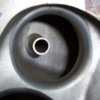The iron 4v heads are nothing for an amateur to fool around with.
Probably the only thing that you should do is put a nice three angle valve job on the seats and blend the 60 cut into the pocket.
Other then that, leave them alone.
They originally had a "venturi" ring cast into the pocket just under the valve to increase velocity into the cylinder.
When you go racing, usually you cut that out. In a street car, you leave the ring alone.
If your guides are shot, go with the full bronze press in guides and just clean up the cast iron pedestal.
Under NO CIRCUMSTANCES do you polish the intake ports. Leave them rough. That helps keep the atomized mixture in suspension.
Stock heads have shown that they will flow right around 300 cfm at .600 lift with just a nice 3 angle valve job.
Race 289 and 427 heads are around 250 to 260 by comparison.
If anything, the heads are border line flowing too much for only 351 ci UNLESS you intend to turn the engine to 8,500 rpm.
It is much safer to take the heads to a very experienced FORD engine shop like Joe Lapine at Danbury Competition.
Let him worry about the details and do what he says to do to them.
I've burned out two of the Sears Craftsman, and the Makita. Currently I'm working on killing a variable speed Roto-Zip. I like it but I hear it "going".
On iron you can use the blue stones. On aluminum you need a pure carbide cutter. The teeth are wider apart to aid in keeping the aluminum from clumping and clogging the cutter. It still does but at a slower rate that you would use on an iron head.
There is also a "cutter lube" that you use with aluminum. You just dip the cutter in the dip and it aids in keeping the aluminum cutter clogs off the cutter.
There are carbide teethed pocket cutters that you can buy in three different od's. They are about $150 each but the advantage is that you just make one plunge cut with it to clean up and shape the pocket.
They already have the shape of the pocket machined in them, so just a slow plunge cut with a drill press or mill will save you hours of time.
It works great on Windsor heads and Chevy's. In fact some of the shops call them 'Chevy pocket cutters'.
I have not used them on a Cleveland and doubt that they would productive, just destructive.
Ported heads are always a risk. For one thing the walls of the ports are only so thick. The other thing is that there can be casting "drop outs" left from the casting process.
They are a little smaller then the size of a pea. If you run into one it will fall out of the port wall and leave a hole through to the water jacket.
IF you have to go into the port to weld up a flaw, as far as I am concerned, the head is junk. Throw it away.
Like I said, best to leave it to an expert. It's true that if you want to be a 'porter' you need to start some where. I can count three sets of heads that I started on that aren't even good paper weights now.
I think cast iron is about $100 a ton in junk? Aluminum is better. About $.23 a pound last time I looked? Maybe better now?



